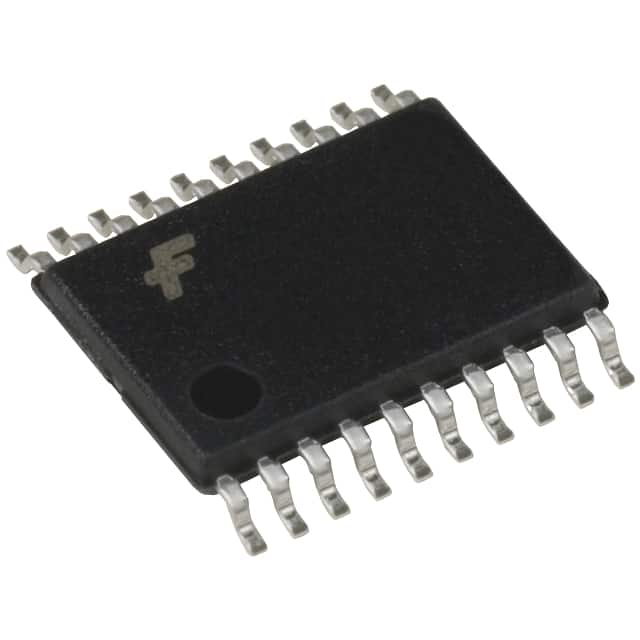Lihat spesifikasi untuk detail produk.

74LCXZ2245MTC
Product Overview
- Category: Integrated Circuit (IC)
- Use: Level Shifter and Bus Transceiver
- Characteristics: Low Voltage, Bidirectional, Octal, Non-Inverting
- Package: TSSOP (Thin Shrink Small Outline Package)
- Essence: A high-performance level shifter and bus transceiver IC designed for low voltage applications.
- Packaging/Quantity: Tape and Reel, 2500 units per reel
Specifications
- Supply Voltage Range: 1.65V to 3.6V
- Logic Voltage Levels: 1.8V, 2.5V, 3.3V
- Number of Channels: 8
- Input/Output Type: Non-Inverting
- Output Drive Capability: ±24mA
- Propagation Delay: 2.5ns (Max)
- Operating Temperature Range: -40°C to +85°C
Detailed Pin Configuration
The 74LCXZ2245MTC has a total of 24 pins. The pin configuration is as follows:
- OE (Output Enable) 1
- A1 (Input/Output) 1
- B1 (Input/Output) 1
- GND (Ground)
- B2 (Input/Output) 2
- A2 (Input/Output) 2
- OE (Output Enable) 2
- VCC (Supply Voltage)
- A3 (Input/Output) 3
- B3 (Input/Output) 3
- OE (Output Enable) 3
- NC (No Connection)
- B4 (Input/Output) 4
- A4 (Input/Output) 4
- OE (Output Enable) 4
- GND (Ground)
- A5 (Input/Output) 5
- B5 (Input/Output) 5
- OE (Output Enable) 5
- VCC (Supply Voltage)
- B6 (Input/Output) 6
- A6 (Input/Output) 6
- OE (Output Enable) 6
- NC (No Connection)
Functional Features
- Bidirectional level shifting between different voltage domains.
- Non-inverting logic translation for seamless communication between devices with different voltage levels.
- High-speed operation with low propagation delay.
- Output enable control for flexible bus management.
Advantages and Disadvantages
Advantages: - Wide supply voltage range allows compatibility with various systems. - Non-inverting nature simplifies the design of bidirectional communication interfaces. - High-speed operation enables efficient data transfer. - Output enable control provides flexibility in managing bus connections.
Disadvantages: - Limited to low voltage applications, not suitable for high voltage environments. - Non-inverting nature may require additional circuitry for certain applications.
Working Principles
The 74LCXZ2245MTC is designed using advanced CMOS technology, allowing it to operate at low voltage levels. It utilizes a combination of level shifting and non-inverting logic translation techniques to enable bidirectional communication between devices operating at different voltage domains. The output enable feature provides control over the direction of data flow, allowing for flexible bus management.
Detailed Application Field Plans
The 74LCXZ2245MTC is commonly used in various applications that require level shifting and bidirectional communication between devices with different voltage levels. Some specific application fields include:
- Battery-powered portable devices: Enables communication between low voltage microcontrollers and higher voltage peripherals.
- IoT (Internet of Things) devices: Facilitates data exchange between sensors and microcontrollers operating at different voltage levels.
- Industrial automation: Allows for seamless communication between control systems and field devices with varying voltage requirements.
- Automotive electronics: Enables bidirectional data transfer between different subsystems within a vehicle.
Detailed and Complete Alternative Models
- 74LVC245A: Similar functionality, but operates at a higher voltage range (1.65V to 5.5V).
- SN74LVCH245A: Offers similar features with a wider supply voltage range (1.2V to 3.6V).
- MC74LCX245: Provides comparable level shifting capabilities with a different pin configuration.
These alternative models can be considered based on specific application requirements and voltage compatibility needs.
Word count: 529 words
Sebutkan 10 pertanyaan dan jawaban umum terkait penerapan 74LCXZ2245MTC dalam solusi teknis
Sure! Here are 10 common questions and answers related to the application of 74LCXZ2245MTC in technical solutions:
Q: What is the function of the 74LCXZ2245MTC? A: The 74LCXZ2245MTC is a bidirectional octal bus transceiver with 3-state outputs. It allows bidirectional transfer of data between two buses.
Q: What is the voltage range supported by the 74LCXZ2245MTC? A: The 74LCXZ2245MTC supports a voltage range of 1.65V to 3.6V.
Q: Can the 74LCXZ2245MTC be used for level shifting between different voltage domains? A: Yes, the 74LCXZ2245MTC can be used for level shifting as it supports multiple voltage domains.
Q: How many channels does the 74LCXZ2245MTC have? A: The 74LCXZ2245MTC has 8 bidirectional channels.
Q: What is the maximum data rate supported by the 74LCXZ2245MTC? A: The 74LCXZ2245MTC supports a maximum data rate of 400Mbps.
Q: Can the 74LCXZ2245MTC be used in high-speed applications? A: Yes, the 74LCXZ2245MTC can be used in high-speed applications due to its fast propagation delay and low output skew.
Q: Does the 74LCXZ2245MTC have built-in ESD protection? A: Yes, the 74LCXZ2245MTC has built-in ESD protection, making it suitable for robust designs.
Q: Can the 74LCXZ2245MTC be used in both parallel and serial communication interfaces? A: Yes, the 74LCXZ2245MTC can be used in both parallel and serial communication interfaces, depending on the application requirements.
Q: What is the power supply voltage required for the 74LCXZ2245MTC? A: The 74LCXZ2245MTC requires a power supply voltage of 2.3V to 3.6V.
Q: Is the 74LCXZ2245MTC available in different package options? A: Yes, the 74LCXZ2245MTC is available in various package options, including TSSOP, SOIC, and QFN, providing flexibility in design integration.
Please note that these answers are general and may vary based on specific datasheet and application requirements.

